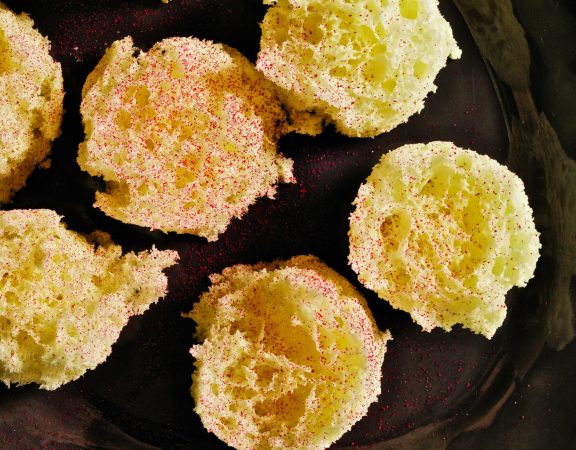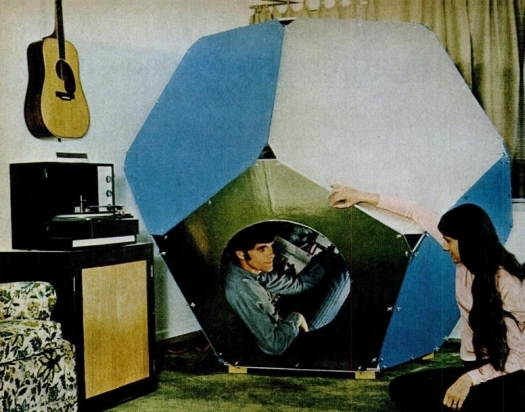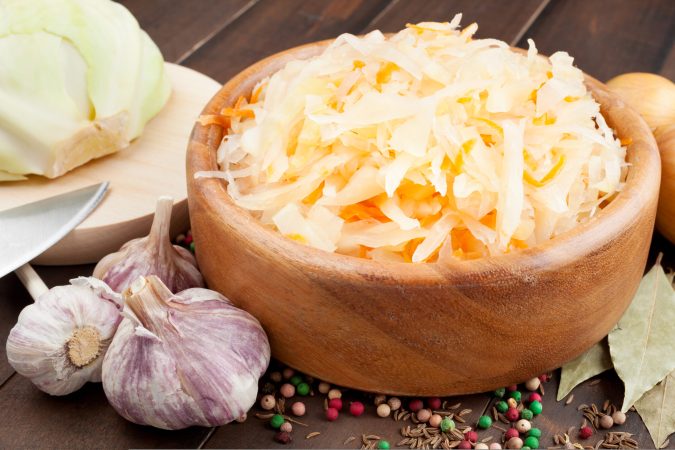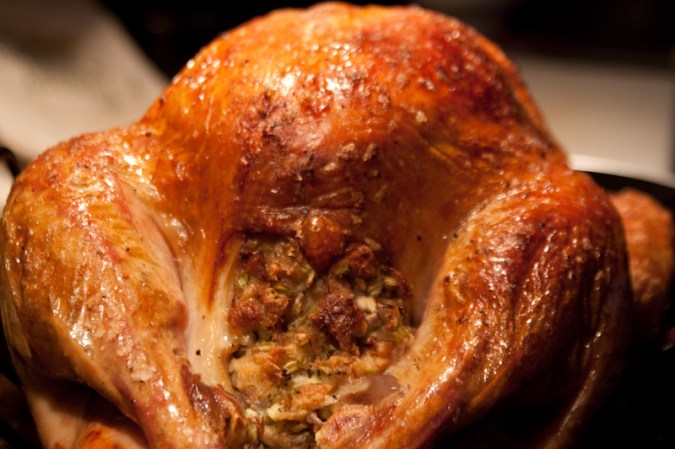

I never thought it was possible to be sick of mac and cheese. Now? I’m not so sure. After Panera Bread found itself at the center of a social media maelstrom for its totally reasonable method of warming up its cheesy pasta by soaking sealed bags of it in hot water, something clicked in the collective Popular Science mind:
Could we make it? From scratch? In… plastic bags?
I had not planned anything for the next day’s dinner, so I jumped at the opportunity to try. We’d get a story and I’d get a hearty meal. Two birds with one mac and cheese, as they say.
Let’s set the stage a bit. Cooking food in plastic bags is not strange, and if you do it right, you can call it sous-vide (French for “under vacuum”). It’s also an acceptable way to warm up various types of food. But as an avid cook and food-lover, I cannot, in good conscience, use such a refined name for a technique that ultimately created the food I have deemed “Bag Mac.”
Don’t waste the good cheese
12:11 p.m. I make my first Google search for “mac and cheese in a bag.” You’ve got to start somewhere.
12:12 p.m. I email Pat Polowsky, a cheese scientist. If I’m going to do this right, I will need all the expert help I can get. I tell him I’m working on a story about how to make mac and cheese “by putting the ingredients in a bag and boiling it.” I have not done much research yet, so I have yet to discover that it’s not a good idea to put plastic into boiling water. It will probably melt. Melted cheese is great over pasta. Melted plastic? Not so much.
12:16 p.m. Polowsky responds, enthusiastically offering assistance—a near-record-breaking response time from a potential source. I tell him I’ll call him once I’ve thoroughly educated myself on the ins and outs of sous-vide and mac and cheese. “This is going well so far,” I tell myself. This will be the last time those words leave my lips today.
12:20-3:20 p.m. I spend three hours trying to figure out the best way to approach the task. This involves checking the latest information on the Panera news (the company defended itself by saying the method helps it avoid using preservatives that don’t meet its standards), reading numerous takes on the kerfuffle, and cobbling together a list of ingredients and steps I think will work best. I briefly consider using a recipe from our sister publication, Saveur, but I know I will hate myself if things go badly and I end up wasting good Gruyère.

3:29 p.m. I text my wife about dinner. “I’m gonna make a lot of mac and cheese and some of it is probably gonna be bad,” I say. “As long as you aren’t wasting my good cheese,” she eventually responds.
3:42 p.m. Confident in my knowledge of mac and cheese, I call Polowsky, but he does not answer. Instead, I decide to investigate the safety of cooking in bags. It’s been established that I don’t want mac and plastic, so I want to make sure I use the right stuff.
3:50 p.m. Polowsky calls me back and we talk about cheese for 20 minutes. He knows a lot about cheese, but he’s never made mac and cheese in a bag. Those two things are almost definitely related.
4:11-5:30 p.m. More plastic research. Some good news: you don’t need special sous-vide bags or a vacuum sealer to cook or reheat food like this. Food-grade, freezer-style, brand-name bags will usually work just as well. The consensus seems to be that the safest plastics for cooking are polyethylene and polypropylene. I checked my gallon-capacity Ziploc freezer bags and saw they’re made of both types of plastic. Great, no need to buy bags at the store.
5:45 p.m. I arrive at the food store and begin filling my basket with everything I need. Check it:
- Elbow pasta. Traditional.
- Cavatappi pasta. I’ve had good results making mac and cheese with this corkscrew-shaped macaroni.
- Mild cheddar. This was a mistake. I’ve always made mac and cheese with sharp cheddar, which gives the dish a nice, cheesy flavor. Without that sharpness, to quote my wife, it “tastes like air.” Unfortunately, I did not realize my error until I was already home and cooking.
- Swiss, smoked gouda, and mozzarella. The kind of cheese (or cheeses, if you’re feeling decadent) you put in your sauce will depend on your personal preference, and has little effect on whether Bag Mac works or not. It’s important to base your sauce on a moderately acidic cheese, though, like young cheddar or gouda, because they melt into a sauce well, Polowsky says. I wanted to try a mix of cheeses, which probably would’ve worked if I had gotten sharp cheddar. Instead, it was a whole bunch of mild.
- Sliced American cheese. I’m not a huge fan of processed American cheese, but it has a surprisingly scientific use in mac and cheese because it includes sodium citrate—an emulsifying salt. These types of salts help cheese melt without becoming too greasy, and when you’re making cheese sauce, that means a creamy texture. If you don’t have sodium citrate in your kitchen (most of you, probably), toss in a couple slices of American cheese to help get that smooth emulsification going.
6:14 p.m. I reach the check-out lane and pile my haul on the conveyor belt. I wonder if my cashier, Rachelle, knows I’m about to make a bunch of mac and cheese. She probably does. I’m literally only buying macaroni and cheese.
How not to cook pasta
7:59 p.m. I am so full of hope and so hungry for mac and cheese. I know I’ll need photos for my eventual story, so I artfully pile my cheese and pasta on the kitchen counter and snap my first photo of the process.

8:00 p.m. I decide to start cautiously, using two bags instead of one for my first batch—one for the pasta and one for the cheese sauce. I do want to see if it’s possible to make it all in one bag, but my wife will be home soon and we will need to eat dinner. Doing it like this is the middle ground between boiling macaroni in one pot and melting cheese in another, so it seems like the method with the highest odds of success.
8:01 p.m. As I settle in for what will likely be an hours-long process, rife with uncertainty, I double my order of time and anxiety by tuning into Game 4 of baseball’s American League Championship Series. The Houston Astros (my team) are ahead two games to one, but playing the Yankees in the Bronx is never easy. As I wait for the game to start, I prepare my recipe. It’s a simplified version of several recipes I found online:
- 8 ounces of pasta
- 2 cups of shredded cheese
- 1/2 stick of butter (sliced)
- 1 cup of milk
- 2 tablespoons of flour
- 2 slices of American cheese
8:07 p.m. I dump the dry elbow macaroni into a bag, successfully completing step one (or so I thought). Then, I shred a mix of cheeses, using the cheddar as a base. It goes into the other bag, followed by the butter, milk, and flour. I topped it all with the sliced American cheese, which I ripped up by hand. It’s the personal touches that really matter when you’re making food.
8:15 p.m. Let’s check in on the water. Polyethylene generally melts somewhere between 220 and 350 degrees Fahrenheit, but because that range seems to vary quite broadly, I didn’t want to boil the pot of water I had sitting on my stove. While it’s easy to tell when water is boiling at 212 degrees, it’s not easy to eyeball 160-180 degrees, which is a good temperature for sous-vide cooking. If I’d used an actual sous-vide device, I would’ve been able to accurately control my water temperature, but I wanted to see if you could do it in a pot. I did, however, use a thermometer.
8:39 p.m. Ok, the water is heating too slowly. I’d had the stove on “medium,” to ensure I didn’t blow past the 180-degree mark, but my wife is going to be home soon and I’m starving. I jack the heat up to “high” and watch the thermometer intently. If only Future John could tell me that I should just watch for small bubbles to start forming at the bottom of the pot and then keep the stove dial at medium. He would’ve saved me a lot of time.
9:10 p.m. The water is at the right temperature, so I seal my bags and plop ’em in. Without a vacuum sealer, you can get adequate results by closing the bag nearly all the way and then just squeezing the air out with your hands. As long as the stuff in the bag sinks below the hot water’s surface, it’ll cook. To avoid entirely submerging the bags—I didn’t want to risk the seals opening underwater—I used binder clips to secure them to the sides of my pot.
9:12 p.m. A problem: the pasta bag is floating. The cheese sauce, however, is slowly melting.
9:15 p.m. I take the cheese sauce bag out of the water, using a hot pad to remove the binder clips and handle the bag until I’m certain it’s not too hot to touch. I shake it around, bounce it up and down on the counter, and generally mix it all up before putting it back in the water. It’s good to do this every five minutes or so with both bags to ensure everything is moving around. The pasta is still hard.

9:20 p.m. The cheese sauce is done. It looks like soft, creamy cheese sauce. I take it out of the pot and let it rest on the counter. The pasta is not done, though. It still looks like it just came out of the box.
9:25 p.m. In a “big brain,” “galaxy brain,” or “200 IQ” move, I believe I’ve solved my pasta problem. I’ve opened the bag, dropped three butter knives into it, and put it back in the pot. The added weight has pushed the pasta below the surface, and I’m confident it will cook.
9:30 p.m. My wife arrives home with ingredients to make herself a sandwich for dinner. She made the right choice. The pasta is still not cooked.
9:35 p.m. The pasta is still not cooked.
9:45 p.m. The pasta is still not cooked.
9:46 p.m. Remember how I said I’d “successfully” completed the first step? I was wrong. I should’ve added water to the pasta before sealing the bag and putting it in the pot. Pasta needs to absorb water to cook, but somehow I assumed that the water in the pot and the pasta in the bag would magically combine to plump my macaroni. Momentarily defeated, I lie down on the floor next to the garbage can, where I belong.
9:47 p.m. All I’ve done in the pasta bag so far is create hot, hard pasta, and three hot knives. I add just enough water to cover the pasta and put it back in the pot. It’s quickly evident that this was the right move all along.
9:57 p.m. The pasta is cooking!
10:07 p.m. Pasta usually takes 8-12 minutes to cook in boiling water, but because my water is hovering between 160-180 degrees, it takes about 20 minutes. The pasta is cooked.
10:08 p.m. The pasta goes into a large bowl, followed by the cheese sauce. It’s a bit soupy for my liking, but it doesn’t taste bad. The pasta has a bit of a weird texture, but that might be because it was heated, dry, for more than 30 minutes. The lack of a sharp cheddar, though, means it’s pretty bland. The flour also didn’t completely mix into the sauce, and it’s kind of lumpy.

Let’s try that again
10:10 p.m. I want to reuse the bags, so I rinse them out and wipe down the inside to get rid of as much water as possible. The one that contained the pasta cleans out easily. The other one does not.
10:15-10:25 p.m. I prepare the ingredients and put them in their respective bags. This time, I use only 1 tablespoon of flour in an attempt to counteract the lumpiness. Then, into the water they go. I also heat up my broiler, pour some of the first batch into a ramekin, sprinkle it with more cheese, and top it with breadcrumbs before popping it into the oven.
10:26 p.m. I remove the ramekin from the broiler. It looks great, but still tastes the same.
10:30 p.m. I lift the cheese sauce bag out of the water for its first agitation and discover it has sprung a leak. Some water has gotten in—not much, but enough that the sauce is unappetizingly watery.
10:31 p.m. Thankful that I didn’t use any of the fancy cheese, I dump the mixture into the sink. A mass of partially-melted cheese plops out, splattering my clothes. Perfect. Swell.
10:35 p.m. New cheese sauce ingredients go into a new bag and into the water. This time, I also attempt to ratchet the flavor up a bit by adding a large helping of a havarti-style cheese.
10:40 p.m. Upon removing the cheese bag to mix it up, it’s clear that it’s way too runny. I toss in another tablespoon of flour and shake it all around, hoping for the best.
10:45 p.m. The pasta is done, but the cheese sauce isn’t. I take it out but leave the cheese sauce in for another 10 minutes, shaking it up after five.
11 p.m. The second batch of Bag Mac goes into a bowl for tasting. The pasta has a better texture, but it’s still not as good as traditionally cooked macaroni. The sauce is still somewhat bland, but the addition of the more flavorful cheese has helped a bit. It’s also still lumpy. Looks like it’s hard, if not impossible, to find a good middle ground between thin and clumpy Bag Mac sauce.
11:06 p.m. I broil a bit of the latest batch to get it crispy and melty. Then, I take a break to watch the game, because I deserve it.

The one-bag method
11:40 p.m. It’s the moment I’ve been dreading, but that you’ve probably been waiting for. I pour 8 ounces of the cavatappi pasta into a new bag, not wanting to risk a leak this late at night. The other ingredients soon join it, forming what looks like the worst macaroni salad ever made.
11:43 p.m. I add more water to the pot, as more than half of it has boiled off at this point, and I need to be sure my Bag Mac is fully submerged.
12:08 a.m. The water is back to about 175 degrees, so I put the bag in. It doesn’t fully submerge, but I hope that once some of the cheese and butter starts to melt, it will move to the bottom of the bag and drag it underwater.
12:15 a.m. That hasn’t happened, and it has become clear that 1 cup of milk was not enough for this batch. I add another cup to the bag, completely covering the pasta. Upon immersion, the ingredients sink below water level.
12:28 a.m. The Astros-Yankees game is over, an 8-3 victory for the visiting Houston team. But I play on.
12:30 a.m. After several shake-ups, the pasta seems to be somewhat cooked, so I taste it. It’s still kind of hard.
12:48 a.m. The Bag Mac is done. I can taste it. I don’t want to, but I have to. For content.
12:50 a.m. I put the first forkful of Bag Mac into my mouth. The pasta is funky. It has a gummy texture, close to what I imagine chowing down on wet toilet paper would be like. It tastes like it has absorbed all the bad flavors in the cheese, butter, and milk. The sauce is pretty much the same as all the other attempts, but slightly more gloopy. I’m not sure if I’m sick of eating mac and cheese or if it’s really as unsettling as it seems.

3:45 p.m. the next day. Yes, it’s still unsettling.
At the end of my 13-hour saga, all I can say is that I can’t recommend anyone try to cook mac and cheese in a single bag submerged in hot water. Maybe there’s a way to do it, but the ingredient ratios would have to be perfect, and frankly, I don’t have the time or the ingredients to make that happen.
Using two bags makes passable Bag Mac, but it’s definitely not better than the traditional stovetop method. Sure, with standard mac-making technique, you need to constantly tend to the cheese sauce, but the time you save by not standing by the stove is negated by the additional time it takes to cook the pasta in a bag. Plus, the sauce will never be as creamy as it could be; it’s been sitting in a bag that you shake around every five minutes. And you’ll save the planet a couple of plastic bags you might have a hard time reusing.
It’s going to be weeks before I can even look at mac and cheese again.















